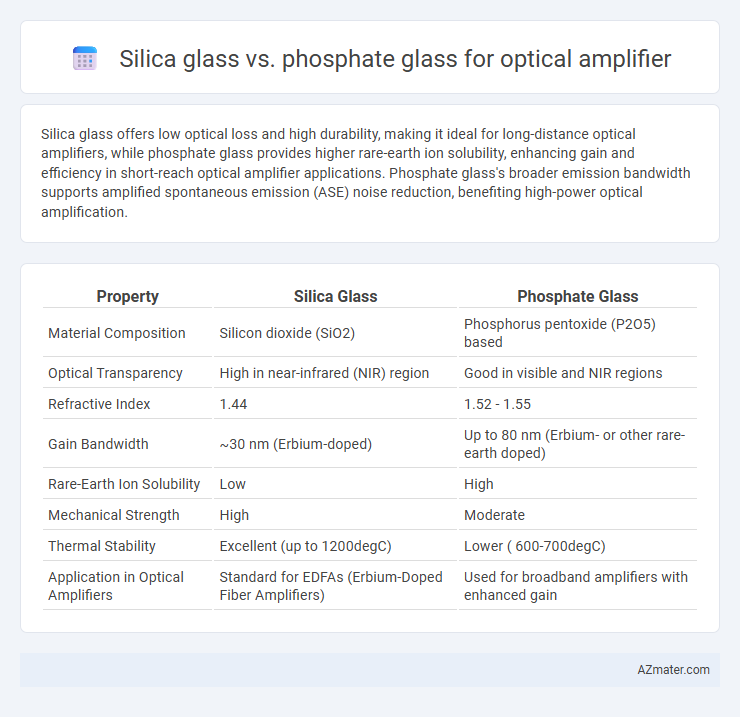Silica glass offers low optical loss and high durability, making it ideal for long-distance optical amplifiers, while phosphate glass provides higher rare-earth ion solubility, enhancing gain and efficiency in short-reach optical amplifier applications. Phosphate glass's broader emission bandwidth supports amplified spontaneous emission (ASE) noise reduction, benefiting high-power optical amplification.
Table of Comparison
| Property | Silica Glass | Phosphate Glass |
|---|---|---|
| Material Composition | Silicon dioxide (SiO2) | Phosphorus pentoxide (P2O5) based |
| Optical Transparency | High in near-infrared (NIR) region | Good in visible and NIR regions |
| Refractive Index | 1.44 | 1.52 - 1.55 |
| Gain Bandwidth | ~30 nm (Erbium-doped) | Up to 80 nm (Erbium- or other rare-earth doped) |
| Rare-Earth Ion Solubility | Low | High |
| Mechanical Strength | High | Moderate |
| Thermal Stability | Excellent (up to 1200degC) | Lower ( 600-700degC) |
| Application in Optical Amplifiers | Standard for EDFAs (Erbium-Doped Fiber Amplifiers) | Used for broadband amplifiers with enhanced gain |
Introduction to Optical Amplifiers
Optical amplifiers utilize silica glass and phosphate glass as core materials due to their distinct spectral and amplification properties. Silica glass offers low loss and high transparency in the C-band, making it ideal for long-haul fiber optic communication systems. Phosphate glass, with higher rare-earth ion solubility and gain bandwidth, enables more efficient amplification and broader wavelength coverage, critical for advanced optical amplifier designs.
Overview of Silica Glass
Silica glass, composed primarily of silicon dioxide (SiO2), is the standard material for optical amplifiers due to its low optical loss, high transparency in the 1.3 to 1.6 um wavelength range, and excellent mechanical strength. It exhibits superior thermal stability and chemical durability compared to phosphate glass, making it ideal for long-haul fiber optic communication systems. The high purity and well-established fabrication processes of silica glass enable reliable erbium-doped fiber amplifiers (EDFAs) with low noise figures and high gain efficiency.
Overview of Phosphate Glass
Phosphate glass offers superior rare-earth ion solubility compared to silica glass, enabling higher doping concentrations crucial for efficient optical amplifiers. Its lower phonon energy reduces non-radiative decay, enhancing fluorescence lifetime and gain performance in fiber amplifiers. Phosphate glass's thermal and mechanical properties provide better preform fabrication flexibility, making it a preferred choice in high-power and broadband optical amplifier applications.
Key Optical Properties Comparison
Silica glass exhibits a high transparency range from ultraviolet to near-infrared wavelengths with a low intrinsic attenuation of around 0.2 dB/km at 1550 nm, making it ideal for long-distance optical amplifiers. Phosphate glass offers a broader doping capacity with rare-earth ions like Erbium and Ytterbium, enabling higher gain and broader emission bandwidths but suffers from higher intrinsic losses, typically around 1-2 dB/m. The refractive index of silica glass is approximately 1.45, providing excellent mechanical stability and low nonlinear effects, whereas phosphate glass has a higher refractive index around 1.52, which enhances amplification efficiency but reduces durability in harsh environments.
Rare-Earth Doping Efficiency
Silica glass demonstrates superior Rare-Earth doping efficiency for optical amplifiers due to its low phonon energy, which minimizes non-radiative decay and enhances luminescence lifetime. Phosphate glass offers higher rare-earth solubility, allowing increased dopant concentrations but suffers from higher phonon energy, leading to greater quenching and reduced amplifier gain. Optimizing Rare-Earth doping in silica glass results in more efficient signal amplification and longer device lifespan compared to phosphate glass counterparts.
Thermal Stability and Durability
Silica glass exhibits superior thermal stability compared to phosphate glass, maintaining its optical properties under high temperatures commonly encountered in optical amplifiers. Its robust chemical durability and resistance to moisture enhance lifespan and performance consistency in demanding environments. Phosphate glass, while offering higher rare-earth ion solubility, generally suffers from lower thermal stability and reduced structural durability, limiting its long-term reliability in optical amplifier applications.
Fabrication Techniques and Scalability
Silica glass used in optical amplifiers is typically fabricated through chemical vapor deposition (CVD) techniques, offering high purity and excellent mechanical stability, which enables large-scale production with consistent quality. Phosphate glass, produced by melting raw phosphate compounds followed by controlled cooling, allows for easier doping with rare-earth ions, enhancing optical gain but presenting challenges in maintaining uniformity during large-scale fabrication. Scalability of silica glass benefits from established industrial processes and infrastructure, while phosphate glass requires more specialized handling to achieve comparable production volumes without compromising optical properties.
Applications in Optical Amplifier Systems
Silica glass is widely preferred in optical amplifier systems due to its low intrinsic loss, high purity, and excellent durability, enabling efficient signal amplification predominantly in erbium-doped fiber amplifiers (EDFAs). Phosphate glass offers higher rare-earth ion solubility, allowing increased doping concentrations and broader gain bandwidth, which is advantageous for advanced amplifier designs requiring high power and wide spectral coverage. The choice between silica and phosphate glasses depends on the specific application demands, such as signal bandwidth, amplifier gain, and compatibility with existing fiber infrastructure.
Cost Analysis and Commercial Availability
Silica glass is widely favored for optical amplifiers due to its low cost and extensive commercial availability, benefiting from mature manufacturing processes and large-scale production. Phosphate glass, while offering superior rare-earth ion solubility and higher gain performance, incurs higher costs stemming from complex fabrication and limited suppliers. The economic efficiency of silica glass combined with its broad market presence makes it the preferred material in large-scale optical amplifier deployments.
Choosing the Right Glass for Optical Amplifiers
Silica glass offers low optical loss, high thermal stability, and excellent mechanical strength, making it the preferred choice for long-haul optical amplifiers. Phosphate glass, while exhibiting higher rare-earth ion solubility and better fluorescence efficiency, typically suffers from increased optical losses and lower durability. Selecting the right glass depends on the application--silica glass suits environments demanding robustness and low attenuation, whereas phosphate glass is beneficial for compact, high-gain amplifier designs requiring enhanced active ion concentration.

Infographic: Silica glass vs Phosphate glass for Optical amplifier
 azmater.com
azmater.com